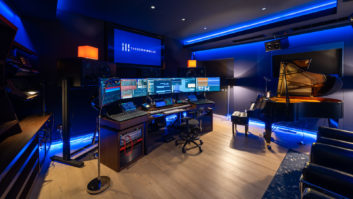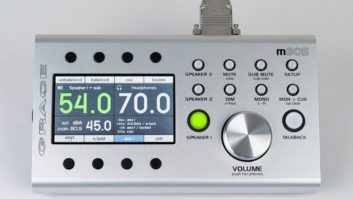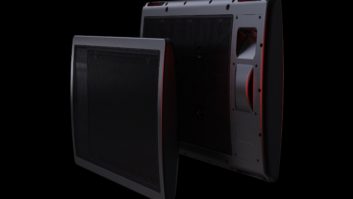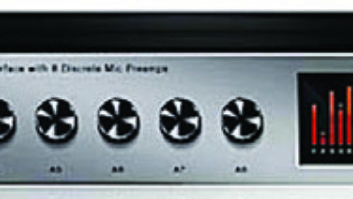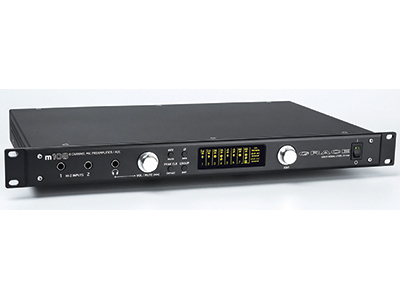
Most pieces of analog audio gear can be categorized by one of two design philosophies. Either the device is designed to impart a unique color or tone, or it strives for accuracy and sonic purity. Since the 1990s, Grace Design has been creating products that trend toward the latter with great success. The company’s mic preamps, compressor and monitor controllers all have the ability to pass signal through their circuits with utmost clarity, detail and robust signal, without introducing additional harmonics or saturation.
In addition to continually striving to produce the highest fidelity tools, Grace designers aim to integrate these tools into the most modern of workflows. The Colorado company’s latest offering, the M108 preamp with ADC, echoes the innovation made available in the M802, an 8-channel, remote-controlled mic preamp. Integration with the Pro Tools through MIDI control provided convenient operation. The M108, builds on this, adding some slick new digital I/O options and a variety of remote-control methods, all while reducing the cost. The end result is a high-quality 8-channel mic preamp with integrated ADC, seemingly perfect for remote recording, broadcast or live sound applications.
GETTING CONNECTED
Most of the M108’s connectivity can be found on the rear panel, with the exception of a pair of instrument jacks and a headphone jack on the front of the unit. On the rear, there are eight XLR input jacks that can accept mic or line-level signals. Each mic preamp has a generous gain range of -6 to 69 dB. The M108 can be used as a purely analog mic preamp, while outputting through a balanced DB25, 8-channel output.
Alternatively, the signals can be A/D-converted and fed to a variety of digital output connectors to ensure compatibility with a variety of interfaces and workflows. Conventional options include an 8-channel AES/EBU output, connected via another DB25. Toslink jacks are also available, allowing high-resolution 24-bit/96kHz S-MUX ADAT operation, though a single jack is able to provide eight channels of ADAT optical signal up to 48 kHz.
The M108 also features a USB 2.0 connection, allowing the unit to perform as an 8×2 DAW interface. When running on a Mac, there is no driver install necessary, and the unit plugs and plays. To facilitate monitoring when recording through the M108, an optional analog output card can be installed, providing a pair of TRS balanced outputs. In the absence of this option, audio can be monitored through the front-panel headphone jack.
Each of these stereo output options presents several choices of source signals. Either can be fed a post-DAW, USB return from the host computer, though this source can be subject to latency, especially considering the reliance on USB 2.0 connectivity. A low-latency blend of input signals can be created instead, using the M108’s integrated mixer, and that can be fed to either or both outputs.
The M108 includes an option slot, which can be loaded with a Dante interface card. For those not yet hip to Dante, it is a digital protocol allowing high-resolution audio in large channel counts, capable of spanning fairly long distances thanks to its use of Ethernet connectivity.
TAKING CONTROL
Adjusting gain, applying phantom power, building the monitoring mix and addressing general settings can all be done through a concise set of controls on the front panel of the M108. In the center of these controls is a fairly large, monochromatic OLED display. This is flanked by two large rotary-encoders with integrated soft-keys which, along with a quartet of additional multipurpose soft-keys, perform all of the control functions.
The two main knobs work in tandem in each menu, with one often focusing on adjusting input gain, while the other is dedicated to building the monitoring mix. It seems that anyone could get comfortable with the preamp functions fairly quickly, as there is plenty of visual feedback and fairly intuitive operation. Jumping back and forth between input gain and monitoring menus gets a little trickier.
Remembering which button to press, or whether you have to hold it or press it once, takes getting used to. Different display modes are available, each prioritizing information on the display differently, which seems like it would help the learning curve, though it only seemed to add more variables. At the end of the day, picking one display mode and getting comfortable with it seems the best strategy.
ETHERNET CONTROL
Aside from the Ethernet connections available on the Dante expansion card, the M108 has its own Ethernet connector for dedicated remote control functions. When connecting this port to a networked router, some very unique control options open up. One is to download the M108 control app for Mac or Windows and run the software on a computer connected to the same network. From this software, global ADC settings like clock source and sample rate can be addressed, as well as channel-specific functions like gain, phantom power, polarity and channel name. When adjusting gain, feedback is provided by a dBFS meter, which is surprisingly quick and responsive.
Once the M108 is connected to a network, the unit’s IP address can be entered into any Web browser and a GUI very similar to the standalone app appears in the browser. One significant omission is the meter, so either the preamp itself, or whatever system it is connected to has to be in view when using IP-based remote control. Despite that, I think this is a pretty cutting-edge innovation because it is completely platform-independent. Whether running a Web browser on Mac, PC or Linux, or on a portable Android, iOS or Windows phone, all devices can control the M108 equally, with no software to install. For me, it worked very reliably across several different devices.
Finally, the M108 borrows a couple of functions from the Grace Design M802 mic preamp. The M802 has a hardware remote control that connects via a DE-9 (Sony 9-Pin) connector using the RS-422 serial machine control protocol. The M108’s back panel has a pair of DE-9 connectors that can be used to connect to the M802 remote, but they also double as a MIDI in and out connector. This unconventional MIDI connector requires an adapter to interface with a standard 5-pin DIN connector, but when employed, it adds the M108 to a short list of mic preamps that can be controlled directly from the Pro Tools HD software. This function is designed to work with the Avid PRE, but the M108 can emulate that unit, allowing Pro Tools to control any function that the M108 and Avid PRE have in common.
While all of these control options can do a great job of setting input levels and global settings, none of them provides any functionality for easing the operation of the M108’s monitor mixer. It seems like the primary function of other interfaces’ software control panels is to ease the functionality of blending playback channels with zero-latency input signals. The visual aspects of fader position and output signal level meters prove very useful in these cases. The absence of any such functions through the M108 control software leaves something to wish for in future software updates.
IN USE
Prior to trying out the M108, I considered the Grace Design m501mic preamp to be a go-to option in any situation that demanded generous amounts of gain, high amount of detail, and the lowest possible self-noise. This included any application where ribbon mics came into play or especially when recording Foley. When the M108 arrived, I was excited to see how it would stack up against its 500 Series sibling. I just happened to be recording Foley, so I quickly put it to the test and was not disappointed.
The M108 delivered the same monstrous amount of gain that I had come to expect from the m501 with the same unnoticeable noise floor. The only real difference that I noticed was that the M108 seemed to take the detail to an even higher level. Everything sounded so clear and present. This was particularly noticeable when performing noise removal. In some cases, despite the low self-noise of the preamp, I still had to remove some ambient room noise.
When removing noise using iZotope RX or other broadband noise removal, I have always noticed that more detailed harmonic structures have held up better to the processing. It seems that it is easier for the software to distinguish between desirable audio and unwanted noise if there is more information to work with. The M108’s tracks managed to stay remarkably clear without being subjected to artifacts, which is a testament to their initial complexity.
When recording any kind of hits or footsteps, the sound was very tight and transient response was very quick. My only complaint was the M108’s fan. In some cases, I was recording myself, and as a result, I was in the room with the preamp. All would be well for a while, but when the fan would kick on; it was very audible. It was the kind of thing that you didn’t really notice in a control room, while listening to audio through monitors, but when the room was miked, you could definitely hear it.
[NOTE FROM GRACE: “The m108 contains a large amount of circuitry in a 1U chassis and under normal operating conditions it will dissipate 20-25W of power depending on user settings. To protect it from excessively high internal temperatures and ensure long term reliability, it is equipped with a variable speed fan.
Whether or not this fan turns on is dependent on several variables: ambient temperature, if there is air movement around the m108, and if the m108 is mounted in contact with other heat generating equipment. The fan will turn on if the main circuit board temperature rises above 45ºC (113ºF). If the m108 is being used in an area where fan noise is undesirable, we simply recommended that it is mounted with space below and above the chassis.”]
I think the most impressive thing about the sound of the M108 was the stereo imaging that it was able to capture. I recorded a variety of acoustic instruments with a combination of spot mics and ambient room mics. In every case, the close mics continued to have the same level of detail that I had been experiencing, with a defined, full-sounding low end. What really caught my attention, however, were the room mics. The localization of sources in the sound field was incredible. When recording an acoustic guitar and an acoustic bass, both miked by the same stereo miking rig plus spot mics, there was full, open sound of the room in the recording and you could see the positioning of the players in your head when listening back.
The DI input was also a solid performer. Recording a DI bass, the bottom end was massive, but the support from the midrange harmonics of the instrument helped maintain an intelligible shape. There was a generous amount of headroom, and I never found myself fighting levels. Sometimes with DI inputs on multi-purpose units like this, things either sound small and thin, or they are pushing distortion. This was not the case with the M108 at all. I could get great tone with responsible headroom, consistently.
THE FUTURE?
It was no surprise that the M108 sounded phenomenal, as that is what we have come to expect from Grace Design. This being my first experience with the company’s A/D converters, I was optimistic, but they may have surpassed my expectations. The imaging was so accurate, it was eerie. With the amount of gain available, coupled with the detail and clarity, this has to be one of the finest preamps on the market today.
The new tech features were also pretty strong. While the USB interface option isn’t the most fully featured, it is a handy function in a pinch and would be useful for remote recording. The Web browser control was very cool and most definitely useful, and while I didn’t have the opportunity to test the Dante option, that technology is on the rise and will most definitely be a draw for many. Altogether, I would say that this is a hit.
PRODUCT SUMMARY
COMPANY: Grace Design
PRODUCT: M108 Mic Preamp/ADC
WEBSITE: www.gracedesign.com
PRICES: $2,845 (street)
PROS: Great sound. Good variety of digital output and control options.
CONS: Not the strongest standalone USB interface.


